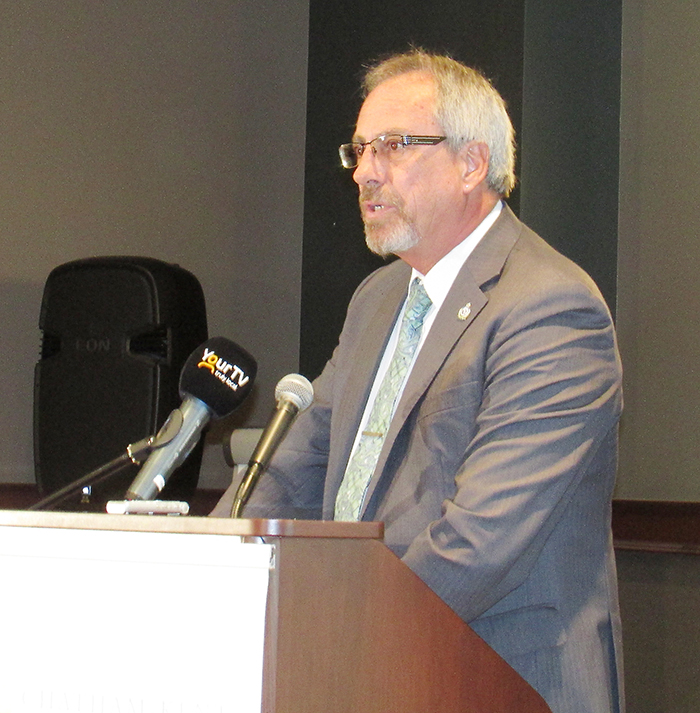
Turn a vacant industrial lot into a bustling sports and transportation hub. That’s a vision Chatham-Kent Mayor Randy Hope discussed at the annual municipal update breakfast put on by the Chatham-Kent Chamber of Commerce May 24.
With the new $36-million Gateway Casino slated to go up at the corner of Richmond Street and Keil Drive, close to the Holiday Inn Express and the John D. Bradley Convention Centre, Hope said the idea of building a twin-pad arena across the street has merit. But he would like to see the property further utilized, adding ball diamonds, commercial outlets, and creating a transportation hub.
Just a day later, added to the council agenda package for the May 28 meeting was a report to council by CAO Don Shropshire recommending council direct administration to develop plans to build a twin-pad arena to replace Erickson and Memorial arenas in Chatham.
A key part of the report was that “administration is seeking direction from council if they support a 4,200 seat Event Centre or a 2,200 seat Community Facility.”
The difference isn’t just in number of seats, as the report states that the capital cost estimate for the Event Centre (4,200 seats), including industry standard amenities, is $52-$56 million. The estimate for the Community Facility (2,200 seats) is $25-$29 million.
Neither estimate includes site acquisition, site remediation, servicing costs, or revenues such as grants and donations.
On Monday night, council directed administration to prepare a feasibility study on the twin-pad idea.
At the breakfast to Chamber members, Hope also detailed the progress the municipality has made in recent years.
Included in that was the reduction in municipal debt. In 2010, the municipal debt sat at $162 million. As of January of this year, it was down to $86 million, Hope said.
All the infrastructure projects underway – including the Fifth Street Bridge and various large-scale road maintenance efforts – are being done without creating additional debt.
“We’re doing it all without borrowing a thing last year and this year,” he said.
In terms of economic development, construction in C-K grew to $144 million in 2017, with $46 million in the greenhouse industry alone.
More than 130 local businesses accessed funding from the Southwest Economic Development Fund, he added, since 2014. And manufacturing companies have invested more than $200 million in capital projects in C-K since that same period.
“Companies do believe in Chatham-Kent,” Hope said. “It’s gotten to the point there is no significant industrial space available.”
To that end, he said the municipality is working on creating 150,000 square feet of new factory floor. Having readily available space fills a constant need.
“Companies want to be in within 90 days,” he said. “But building a factory takes at least six to nine months.”
Hope also defended and detailed spending for international travel.
“Because we live in a global economy, we have to raise our profile. We have to be on the front of the stage,” he said. “We travel to support our businesses as well. We saved one from bankruptcy and allowed another to expand.”
Hope said municipal expenses for travelling abroad for the past five years totaled $244,502, with more than $126,000 of that covered by the federal government.
“It is a reasonable expense to make sure Chatham-Kent is at the front of people’s minds in places around the world,” he said.
Hope also discussed land development and urban boundaries.
“We have to set our path to where we want to grow,” he said.
He wants that path, in and around Chatham at least, to head south, closer to Highway 401, rather than north.
“If we don’t, we will be spending money on a new bridge over the Thames,” he said.
The mayor also reiterated his longstanding desire to see an interchange at Charing Cross Road and the 401.
“We need a gateway to the community that is attractive to visitors,” he said, adding driving north on that road would take visitors past estate-sized lots and not through industrial parts of town, which is what generally happens when people access Chatham off the Communications Road and Bloomfield Road exits.
The sticking point remains who pays for such an interchange, as the provincial government has shown little interest so far.






